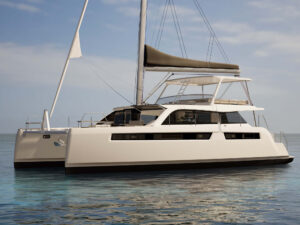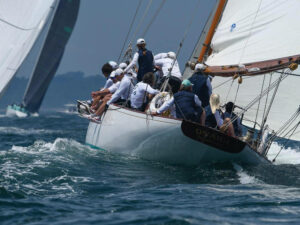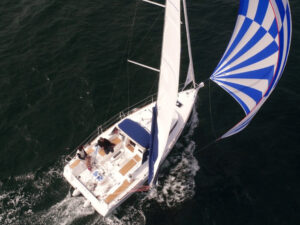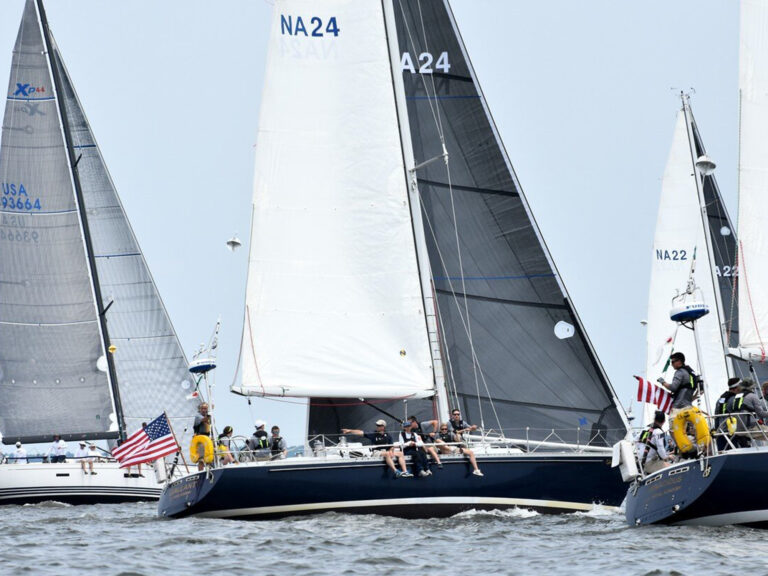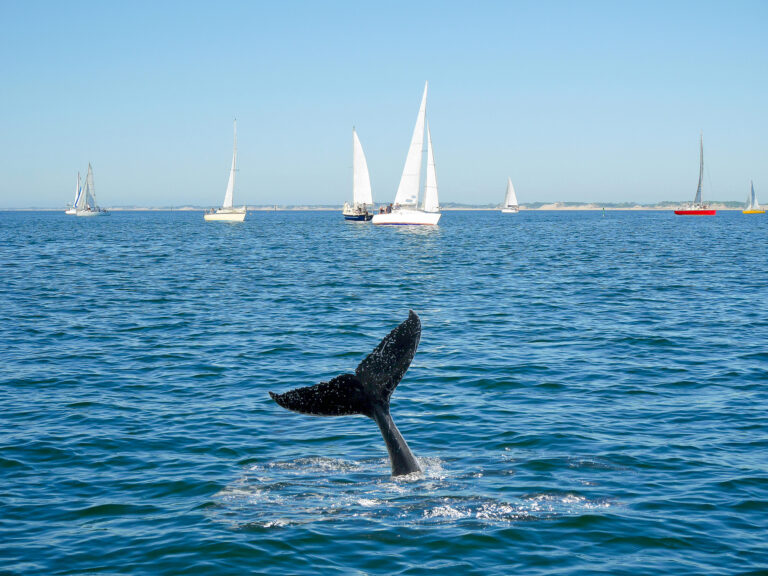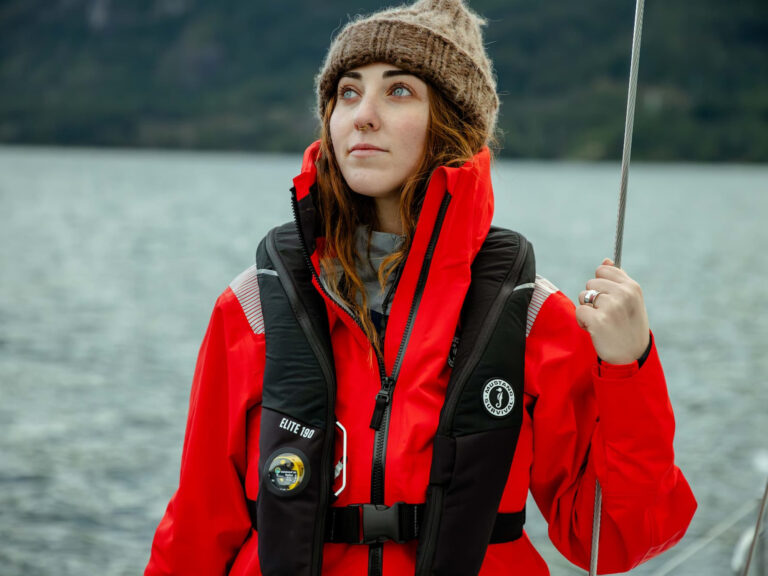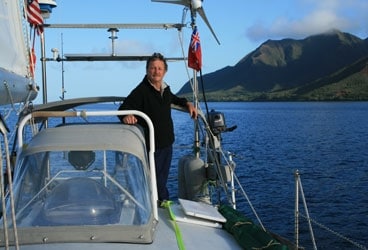
Alvah Caledonia 368
Whoever coined the expression “It’s not the destination; it’s the journey” wasn’t on board Roger Henry with Diana and me during our recent voyage from New Zealand to New Caledonia.
The entire ordeal, in many ways, was all my fault. First, for spending four years on land. What was I thinking? Don’t get me wrong; some of my best friends live on land. It doesn’t make you a bad person. But it’s simply not good for my fitness, my judgment, my sea legs, or my sea stomach.
Second, I didn’t follow my own advice about departures. Wasn’t it I who preached to seminar audiences that the calendar was the most dangerous piece of equipment on a 36-foot steel cutter? “You must move to natural rhythms, not artificial dates or deadlines.” That’s me talking. Hadn’t I warned many a crew to keep their intended dates of departure flexible and top secret?
Had I not cautioned them to factor in the project-swamping flood of dock strollers, well-wishers, friends, and family dropping by the boat to say their second-to-last good-byes?
I believe that it was when the throng stood knee-to-knee in the cockpit, just as another group thundered down the dock, that I forgot to secure that last mushroom vent.
While other skippers debated something called a “weather window,” I admonished Diana: “When did a little weather ever stop us? We prepare the boat for the worst, hope for the best, and leave tomorrow.” If I could’ve kept them down, I would’ve eaten those words.
We were exhausted before we left the dock, and almost prostrate halfway through the first gale, which, of course, was a snarling headwind opposed to the current. The seas were churned into hull-thumping chaos, as were all the improperly stowed items on deck and below.
The hawse hole let in torrents of seawater from the ever-submerged bow. The overboard flag ripped free of its sheath, shredding itself in a nerve-shattering staccato. Reefing lines melded into a Gordian knot, and salt water flowed from the apparently, but not actually, secured vent into the electronics cabinet, causing unspeakable damage. Forget about teaching old sea dogs new tricks; this was about relearning the old ones.
So it was with some relief that, 10 days out of New Zealand, we hoisted our quarantine and courtesy flags and entered the coral pass into the placid protection of the world’s largest lagoon. As we beam-reached through crystalline waters past the historic Amedee lighthouse, its tiny island fringed with swaying palms and white-sand beaches, a French yacht sailed up on our port quarter. A pretty girl in a scant bikini held the helm while her husband pulled in a massive and, as we later learned, succulent Spanish mackerel. He shouted, “You want some feeesh?” The trip’s harsh memories blew away right then and there.
Even the normally tedious entry formalities didn’t burst our utopian bubble. By VHF we were directed to tie up to the well-marked visitors dock in Port Moselle, Noumea; there would be no charge for the first night.
Although Carole, the smiling Kanak woman at the front desk of the port captain’s office, may have appreciated my stumbling attempt at French, she put us out of our mutual misery with her perfect English.
“Quarantine, immigration, and customs officials will come to your boat. Fill these forms out in advance. Have your fruits, vegetables, and any fresh dairy or meat products ready for them to confiscate. If customs hasn’t inspected your boat within two hours of your arrival, consider yourself checked in and haul down the Q flag. Welcome to New Caledonia.”
Immigration procedure consisted of a quick stamp in the passport and a handshake. In a spirit of can-do flexibility, the quarantine office decided to let us keep our beloved cat, Halifax of the North, on board-if we promised to have her out of the country within two months. Customs never did arrive, alleviating concerns about our slight overstepping of the liquor allowance.
This good start would soon grow even better. I’m a member of an international sailing fraternity called the Brotherhood of the Coast. (See “Breaking Bread: The Brotherhood of the Coast,” Shoreline, page 22.) The New Caledonia chapter invited me to accompany them to a nearby island for two days of what I’d describe as a crazed orgy of fine food and wine. The French call it lunch.
You may be excused for thinking that you’ve mistakenly picked up a culinary magazine instead of one devoted to sailing. But I can’t help but go on about the food, because cruising under sail isn’t just about our boats and the people on board; it’s also about the different places, peoples, and customs that landfall delivers. Along with the indelible impressions of Caledonia’s endless beaches, lush coral gardens, and the exotic mix of French and Melanesian culture will remain memories of the gastronomic delights of this Paris of the Pacific. The quality and quantity of the food is a central and defining theme in the lives of the Caledonians.
The open market adjacent to the marina basin fairly bursts with a cornucopia of fresh herbs, vegetables, succulent fruits, plump shrimp, octopus, and lobster. Aged tuna, indistinguishable in texture and taste from the finest beef fillet, is laid out in enticing rows. The smell of fresh-baked croissants and baguettes wafts through the air. Even if a line has formed, the French butcher chats at length with each customer while lovingly laying out veal, venison sausage, capons, quail, and tough old roosters, the piece de resistance in coq au vin.
You don’t buy food for the week; no, that’s for the Americans, always in a hurry. Each day one goes through the reaffirming ritual of smelling, squeezing, and assiduously selecting the freshest and finest ingredients in expectation of a leisurely repast with family and friends.
As she might of textile arts in other nations, Diana can now speak of New Caledonia’s decadent pastries with some expertise. My cultural interests led me toward the vintner’s art in search of exquisitely earthy yet affordable Bordeaux imported from France. After exhaustive research, I found my Holy Grail in the form of a 2003 Medoc for less than $10.
Of course, this opulent lifestyle has come at a cost. From its first sighting in 1774 by Captain James Cook to the recent past, European involvement and eventual French possession of the islands has been a brutal process of exploitation and extraction. Aromatic sandalwood was ripped from the forests, fish from the seas, and countless billions of tons of nickel-rich earth from the hills.
Yes, the profits from mining especially underwrite the viability of eventual independence, fuel a vibrant economy, provide safe roads, and staff schools and clean clinics in ways far superior to the surrounding island nations. But the legacy of colonial rule has left deep scars on the land and the psyche of its native people.
Because New Caledonia was an early French penal colony awash with convicts, indigenous labor was at first not an issue. Those Kanaks, as the indigenous Melanesians are known, not decimated in skirmishes or epidemics were herded into what were essentially mountain reservations while the fertile soil was put into colonial ownership to grow the ever-profitable coffee. But when the flow of convicts was stemmed in 1897, the Kanaks were pressed into indentured service, often treated with such cruelty and disregard as to make actual slavery almost preferable.
Despite a tidal wave of successful independence movements in Melanesia-in Fiji, the Solomon Islands, Vanuatu, and Papua New Guinea-every organic move toward cultural recognition, much less autonomy or independence, was crushed with ruthless efficiency by French landowners, the gendarmes, or the clandestine arms of the French government. As recently as the late 1980s, to lead a pro-independence political party was to sign your own death warrant, for Kanak leaders fell like mangoes from a tree under a hail of assassins’ bullets.
The final leader to fall after the violent deaths of his brothers and all his political associates was Jean-Marie Tjibaou. He was a visionary, a brave man of such noble stature, charisma, and peaceful intent that all but the most hardened colonial reactionaries were appalled by this final injustice. Ironically, the bullet that was supposed to silence the independence movement only served to accelerate it.
It has now been agreed that a referendum on independence will be held in 2014. If the motion isn’t carried then, another referendum will be held in 2017, and yet another in 2020. It seems inevitable, especially given the United Nations’ stated support, that New Caledonia will choose to go it alone as a small, fragile, but autonomous nation.
But no one can ignore the many positive contributions made by French settlers here and their essential role in the future of the nation. There’s little talk of purging them of their land or citizenship. We met Raymond Chenier, a tough and resourceful French sailor, pilot, engineer, and cowboy farmer, and he talked openly about the issues.
“My grandfather came to these shores in 1900 as a seaman,” Raymond told us. “He became captain of the interisland ship. My father was born here. I was born here. My daughter was born here. My granddaughter was born here. We are Caledonians. If trouble comes, some of the newer French arrivals will go back to France. But we have nowhere to go. This is our home.”
When pressed, he gave his predictions for the future. “Independence will come,” he said. “I think it’d be better sooner rather than later. There will be some trouble, for there are a few radicals on both sides. But we hope that with patience, we can get through this, much like Vanuatu has done, and get on with building our country to the benefit of all Caledonians.”
Fortunately, there’s a lot of country to build. Grande Terre, as the main island is locally known, is 250 miles long and 35 miles wide. The large off-lying islands of Île des Pins, Îles Belep, and several in the Îles Loyaute as well as a scattering of reefs extend New Caledonia’s territorial waters across a significant swath of the South Pacific. This verdant, mountainous land, gifted with 1,000 miles of coral reef, idyllic weather, and postcard beauty, lies strategically close to Australia and New Zealand, creating a reliable base for regional tourism. Add the seductive blend of French and Melanesian cultures, and the appeal goes global.
To sustain that tourism, however, residents will have to address serious environmental issues. About 80 percent of the native forests have been cut away, leaving the land vulnerable to destructive erosion.
Cut this land, and it bleeds red into the blue sea. Diana and I sailed past mountain after mountain whose entire tops have been lopped off and carried away to the smelters. The mining roads lie like a lace on the land. During the rains, they become rivers of crimson mud gushing directly into the fragile lagoon.
Still, even in the bowels of the southern mining region, we found pristine cascades and pools to bathe in, lovely trails to wander, and, in the continuing spirit of epicurean hedonism, raw oysters the size of a boxer’s fist to slurp down in the cockpit at sunset.
Given that more than 1,200 yachts arrive here annually from overseas, we found an inexplicable solitude almost everywhere we ventured.
This wasn’t the case in Île des Pins, the island the cruising guide refers to as the Pearl of the Pacific. We anchored in the only port, at Baie de Kuto, to marvel at how idyllic and empty it was.
It wasn’t to last. We woke in the morning to a beach veritably paved with people. A cruise ship had landed and disgorged 900 bright-white Australians. And it was, as they would say, “all on, mate”: T-shirt stands, food vendors, Rasta-man gigolos, rental bikes and cars, guided tours. Nine hundred identical yellow towels bobbed in the breeze like a grove of quaking aspens.
This was too much for us, so we slipped out under full main, jib, and staysail toward nearby Îlot Moro. The twisting entry through an elusive coral pass assured little or no company. In 10 feet over white sand, we dropped our anchor. I couldn’t wait to get ashore to explore our private nature reserve.
Diana was at first happy to join me in a stroll down the flour-white beach and even into the scrubby, limestone interior. Because she’s otherwise so ladylike, I won’t repeat the word she screamed when she first brushed up against the spider’s entangling web. The outburst was prompted by abject terror. This is her worst Indiana Jones nightmare-giant spiders, lots of giant spiders. She failed to see the beauty in the delicate contrasts of lime green and brown on their fat, squishy bodies.
She fled to the open safety of the beach. From the bushes I teased her about her timidity. Any hopes of coaxing her back inland were dashed when I almost tripped over an 8-foot banded sea snake. When I got my heartbeat and dignity back under control, I noticed that I’d been strolling through underbrush littered with dozens, if not hundreds of these silent, lethal, supposedly marine serpents. That sealed the deal for Diana, who vowed to remain ship-bound for the duration.
Unfortunately, a forecast of westerly winds drove us away. We reached back up to the east coast of the mainland for a leisurely probe north. By day, we watched pods of humpback whales pirouette, leap, slap, and dash in a drunkenlike state of love. By sundown, we’d be anchored deep in a mainland bay or tucked up tight behind a tiny islet perched on the outside reef.
Through a scattering of small villages, we used grocery shopping as an excuse for cultural exchange. No one questions your purpose when you have a fresh baguette in hand. French rap and reggae music drifted through streets neatly lined with Western-style cinder-block houses and the traditional thatched conical cases. Young men with beaded dreadlocks and Che Guevara T-shirts swaggered in solidarity to the message and beat of Bob Marley.
Their militant airs proved more bark than bite, because once I broke the ice with a smile and a handshake, I found them to be remarkably friendly, given their turbulent past.
As Halifax’s visa drew near its expiry date, we were forced back to the modern bustle of Noumea. Here we reprovisioned as best as our paltry budget allowed, for among all the laudatory adjectives and accolades heaped on New Caledonia, no one has called it inexpensive.
All accounts agreed that the Îles Loyaute would be the gem of any New Caledonian cruise. Our problem was that clearance facilities only exist in Noumea, and officially at least, once clearance is obtained, one has three days to exit territorial waters.
The scuttlebutt on a noted cruising website said that the officials were somewhat flexible concerning this. But I hate having to look over my shoulder, so I went to customs and immigration and posed the question directly. Perhaps it was a bad move, because I was now on record as being officially told that the limit was indeed three days.
In Lifou, the middle of the Îles Loyaute, Diana and I dove on a reef so lush that it called to mind Claire Booth Luce’s eloquent description of her first reef: “What fishes like flowers, what stones like trees. The coral reefs are a golden girdle of dead and living cities, which dwarf in their age and beauty all the cities of man.”
Ours was but a light brush with this lovely land. In retrospect, I seriously regret not having set sail immediately upon arrival in New Caledonia for the Îles Loyaute, as they’re certainly the highlight, physically and culturally.
I don’t like leaving a land with regrets; it speaks of my mismanagement of a precious opportunity. Now that Roger Henry is more shipshape, and I’m operating in a more Bristol fashion, I’d like to go back to New Caledonia and climb higher, dive deeper, and delve more thoroughly into this rich blend of cultures, this time to enjoy both the journey and the destination, for in cruising, they’re truly one.
Alvah and Diana Simon, recipients of the Cruising World Outstanding Seamanship Award, are en route to Japan, Kamchatka, and Alaska on board Roger Henry.


